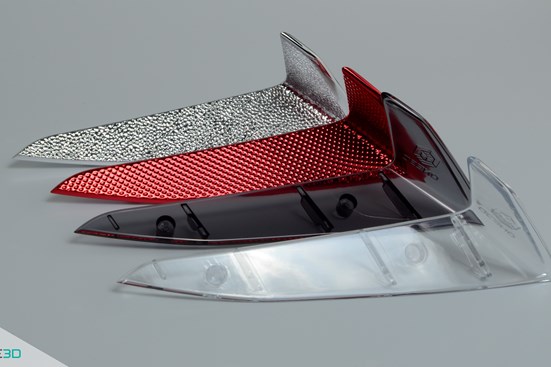3D printed lens prototypes are the latest innovation in automotive lighting system applications. One3D uses them for companies including HELLA, Varroc and MSV Elektronika rail vehicle parts. The companies use the lenses as a visual aid to confirm designs before going into large-scale production.
3D printing and Stratasys Neo800 stereolithography technology shorten the process to produce the lenses to 3-4 working days, compared to 3-4 weeks for milled PMMA (plexiglass). Companies are moving away from the high lead times and production costs of PMMA and turning to 3D printing to produce new lens design prototypes for future development and innovation concept products. 3D printing offers cost and time savings for companies who must consider lead time and budget when proceeding with production.
3D printing prototype parts offers designers the freedom to build lenses with intricate designs. Design iterations can happen more quickly than with traditional manufacturing methods, in which changes to molds are costly and time consuming.
One3D chose the Stratasys Neo800 and Somos® WaterClear Ultra 10122 resin to produce highquality, transparent lens prototypes for their customers. Thanks to the design freedom offered by stereolithography technology and the Stratasys Neo800, One3D can produce large parts with any geometry the customer requests, at a fraction of the cost of traditional prototype production. One3D was able to provide customers with a better cost-per-piece ratio in small series than conventional manufacturing methods would have allowed.
Somos® WaterClear Ultra is an optically clear resin with ABS properties, perfect for applications requiring optical clarity, such as automotive lenses, bottles, fluid flow analysis, packaging, prototypes, light pipes and more. The raw parts produced from Somos® WaterClear Ultra are Technology sanded through different grits, and then multiple layers of clear coat are applied to achieve transparency. Post-processing takes up to 6 hours, to produce quality parts with the highest optical clarity.
The Stratasys Neo800 prints parts top-down, so less force affects the printed part. One3D can optimize the part before printing by adjusting or removing supports as needed. This simplifies post-processing and speeds up the prototyping production process. Optimizing the part where necessary also allows One3D to avoid the positions of optical surfaces and focus on production clarity and transparency.
The Neo800’s large 31.50 × 31.50 × 23.62 in. (800 x 800 x 600mm) building platform offers users the ability to build larger parts without the need to cut. No cuts mean no gluing or imperfections, which in turn reduces postprocessing times and results in lower costs.
The Stratasys Neo800 is reliable, easy to use, and capable of producing outstanding parts with extreme quality and clarity. The Neo800 made it possible for One3D to produce large, state-ofthe-art lenses for its customers, positioning it as a leader within the automotive sector.

